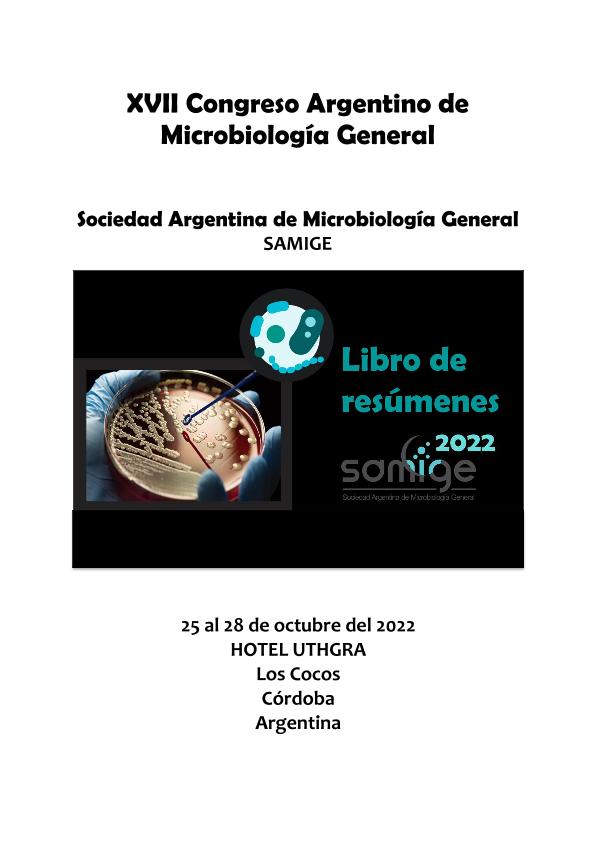Mostrar el registro sencillo del ítem
dc.contributor.author
Lobo, Constanza Belén

dc.contributor.author
Correa Deza, Maria Alejandra

dc.contributor.author
Arnau, Victor Gonzalo

dc.contributor.author
Ferrero, Marcela Alejandra

dc.contributor.author
Juárez Tomás, María Silvina

dc.date.available
2023-09-01T14:00:02Z
dc.date.issued
2022
dc.identifier.citation
Dibenzothiophene removal and effect on physiological properties of polycyclic aromatic compounds- removing bacteria; XVII Congreso Argentino de Microbiología General; Los Cocos; Argentina; 2022; 69-70
dc.identifier.uri
http://hdl.handle.net/11336/210153
dc.description.abstract
Polycyclic aromatic sulfur heterocycles (PASHs) are within a priority pollutant group recognized by the Environmental Protection Agency (EPA). Among PASHs compounds, approximately 70% is represented by dibenzothiophene (DBT), whose contact, ingestion or inhalation has proven to be harmful to human health. Furthermore, DBT is resistant to biodegradation in the environment due to the presence of sulphur atoms. Several bacterial species capable of degrading DBT have been reported in the literature. In order to overcome and persist in polluted environments, microorganisms have developed specialized physiological properties, such as changes in cell surface hydrophobicity (CSH), auto-aggregation (AA) ability, biofilm formation and bioemulsifying activity (EI-24). The aim of this study was to evaluate the physiological properties after DBT exposure of six polycyclic aromatic compounds-removing bacteria as well as their DBT-removing capabilities. The strains were cultured in JPP broth (stationary phase of growth, 30°C, 180 rpm, control medium) and JPP broth with 0.2 mM of DBT (JPP-DBT, 7 days, 30°C, 180 rpm). After that, the physiological properties in both media and DBT removal in JPP-DBT were evaluated. Spectrophotometric methods were used to determine CSH, AA and biofilm formation. The non-polar solvent mechanical agitation method was used to evaluate EI-24. DBT analysis was carried out by reverse phase high performance liquid chromatography. The highest CSH percentages after DBT exposure were observed in Bacillus sp. B18, Rhodococcus erythropolis 20 and Rhodococcus jostii 016 (70%, 84% and 64%, respectively). Only in the case of Rhodococcus sp. F27 an increase (1.73 times) in the AA percentage in presence of DBT was observed. Bacillus sp. B18, Pseudomonas sp. P26, and Gordonia sp. H19 were highlighted with the highest EI-24 values (39%, 27% and 24%, respectively) after DBT exposure. Particularly, Pseudomonas sp. P26 stood out for a 35-fold increase in biofilm formation in the presence of DBT together with a high DBT removal capacity (48%). The results obtained demonstrate that the microbial physiological properties evaluated represent valuable tools to optimize the microbial removal process and therefore bioremediation can be an effective alternative for DBT removal.
dc.format
application/pdf
dc.language.iso
eng
dc.publisher
Sociedad Argentina de Microbiología General
dc.rights
info:eu-repo/semantics/openAccess
dc.rights.uri
https://creativecommons.org/licenses/by-nc-sa/2.5/ar/
dc.subject
BACTERIA
dc.subject
POLYCYCLIC AROMATIC SULFUR HETEROCYCLES
dc.subject
CELL SURFACE PROPERTIES
dc.subject
BIOEMULSIFYING ACTIVITY
dc.subject.classification
Biotecnología Medioambiental

dc.subject.classification
Biotecnología del Medio Ambiente

dc.subject.classification
INGENIERÍAS Y TECNOLOGÍAS

dc.title
Dibenzothiophene removal and effect on physiological properties of polycyclic aromatic compounds- removing bacteria
dc.type
info:eu-repo/semantics/publishedVersion
dc.type
info:eu-repo/semantics/conferenceObject
dc.type
info:ar-repo/semantics/documento de conferencia
dc.date.updated
2023-08-14T11:02:03Z
dc.journal.pagination
69-70
dc.journal.pais
Argentina

dc.description.fil
Fil: Lobo, Constanza Belén. Consejo Nacional de Investigaciones Científicas y Técnicas. Centro Científico Tecnológico Conicet - Tucumán. Planta Piloto de Procesos Industriales Microbiológicos; Argentina
dc.description.fil
Fil: Correa Deza, Maria Alejandra. Consejo Nacional de Investigaciones Científicas y Técnicas. Centro Científico Tecnológico Conicet - Tucumán. Planta Piloto de Procesos Industriales Microbiológicos; Argentina
dc.description.fil
Fil: Arnau, Victor Gonzalo. Consejo Nacional de Investigaciones Científicas y Técnicas. Centro Científico Tecnológico Conicet - Tucumán. Planta Piloto de Procesos Industriales Microbiológicos; Argentina
dc.description.fil
Fil: Ferrero, Marcela Alejandra. Consejo Nacional de Investigaciones Científicas y Técnicas; Argentina. YPF - Tecnología; Argentina
dc.description.fil
Fil: Juárez Tomás, María Silvina. Consejo Nacional de Investigaciones Científicas y Técnicas. Centro Científico Tecnológico Conicet - Tucumán. Planta Piloto de Procesos Industriales Microbiológicos; Argentina
dc.relation.alternativeid
info:eu-repo/semantics/altIdentifier/url/https://samige.org.ar/wp-content/uploads/2022/10/Libro-de-Resumenes-SAMIGE-2022_final.pdf
dc.conicet.rol
Autor

dc.conicet.rol
Autor

dc.conicet.rol
Autor

dc.conicet.rol
Autor

dc.conicet.rol
Autor

dc.coverage
Nacional
dc.type.subtype
Congreso
dc.description.nombreEvento
XVII Congreso Argentino de Microbiología General
dc.date.evento
2022-10-25
dc.description.ciudadEvento
Los Cocos
dc.description.paisEvento
Argentina

dc.type.publicacion
Book
dc.description.institucionOrganizadora
Sociedad Argentina de Microbiología General
dc.source.libro
Libro de resúmenes del XVII Congreso Argentino de Microbiología General
dc.date.eventoHasta
2022-10-28
dc.type
Congreso
Archivos asociados
